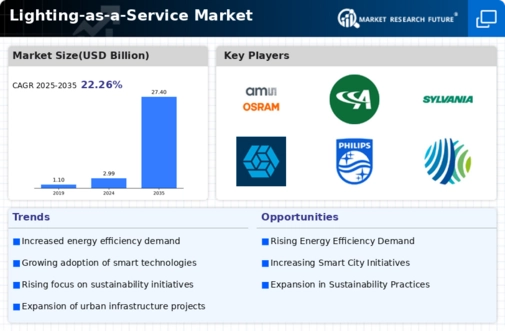Top Industry Leaders in the Lighting-as-a-Service Market
Competitive Landscape of Lighting-as-a-Service
The Lighting-as-a-Service (LaaS) market is illuminating a dynamic and rapidly evolving landscape. With a projected compound annual growth rate (CAGR) exceeding 40%, this multi-billion dollar industry is attracting a diverse range of players vying for a slice of the pie. Understanding the competitive landscape is crucial for both established companies and aspiring entrants.
Key Players:
- Philips NV (Netherlands)
- General Electric Lighting (US)
- Itelecom (Chile)
- Valoya Oy (Finland)
- RCG Lighthouse (Latvia)
- Metrus Energy Inc (US)
- Zumtobel Group Ag (Austria)
- LEDVANCE GmbH (Germany)
- Lunera Lighting (US)
- Enlighted Inc. (US)
Strategies Adopted:
- Technology Differentiation: Players are investing heavily in advanced technologies like LED fixtures, sensors, and data analytics platforms to differentiate themselves. Automation, remote monitoring, and dynamic lighting adjustments are becoming key selling points.
- Subscription Model Innovation: Diversifying subscription models and offering flexible payment options are critical for attracting and retaining customers. Pay-per-lux, outcome-based models, and bundled services with maintenance and data insights are gaining traction.
- Partnerships and Acquisitions: Strategic partnerships and acquisitions are accelerating market consolidation and allowing players to expand their reach and expertise. Collaborations with building management systems providers, energy utilities, and real estate developers are fostering holistic LaaS solutions.
- Sustainability Focus: Sustainability is becoming a prime differentiator, with players emphasizing energy efficiency, carbon footprint reduction, and circular economy principles. Green certifications and adherence to environmental regulations are crucial for attracting eco-conscious clients.
Factors for Market Share Analysis:
- Geographical Focus: Understanding regional strengths and regulations is key. The APAC region is predicted to witness the fastest growth, while North America and Europe remain established markets.
- End-User Segments: Different segments have varying needs and budgets. LaaS providers must tailor their offerings to appeal to offices, retail spaces, industrial facilities, and public infrastructure projects.
- Technology Deployment Level: The level of existing lighting infrastructure and IoT integration plays a crucial role. Players must offer retrofit solutions for older buildings and cater to varying levels of smart technology adoption.
- Pricing and Service Variety: Competitive pricing structures and comprehensive service packages, from installation and maintenance to remote monitoring and data analysis, are essential for securing market share.
New and Emerging Companies:
- Start-ups: Innovative start-ups like Enlighted Inc. and Lunera Lighting are disrupting the market with cutting-edge technologies and niche solutions. Their agility and focus on specific applications allow them to carve out unique positions.
- Energy Service Companies (ESCOs): ESCOs are entering the LaaS market, leveraging their expertise in energy efficiency projects to offer bundled solutions that optimize lighting alongside other building systems.
- PropTech Players: Property technology companies are integrating LaaS with smart building platforms, offering data-driven solutions that enhance energy savings and occupant comfort.
Current Investment Trends:
- Technology Acquisition: Players are acquiring companies or investing in R&D to bolster their technological capabilities in areas like IoT, sensor technology, and data analytics.
- Geographical Expansion: Established players are venturing into new geographies, particularly in the high-growth APAC region, while regional players are seeking international partnerships for wider reach.
- Partnerships and Collaborations: Strategic partnerships and collaborations with technology providers, ESCOs, and building management systems companies are accelerating market consolidation and innovation.
- Vertical Integration: Some players are vertically integrating their operations, acquiring LED manufacturers or luminaire producers, to gain greater control over supply chains and cost-efficiency.
Latest Company Updates:
- Nov. 30, 2023: Signify announces LaaS partnerships with Schneider Electric and Citytrust to expand smart building offerings.
- Dec. 20, 2023: Philips launches new horticultural LaaS solution optimized for vertical farming applications.
- Jan. 2, 2024: Valoya Oy acquires Finnish LED specialist Greenlux, strengthening its horticultural lighting LaaS portfolio.
- Dec. 19, 2023: GE Lighting sells its European LaaS business to Signify, consolidating market leadership.









